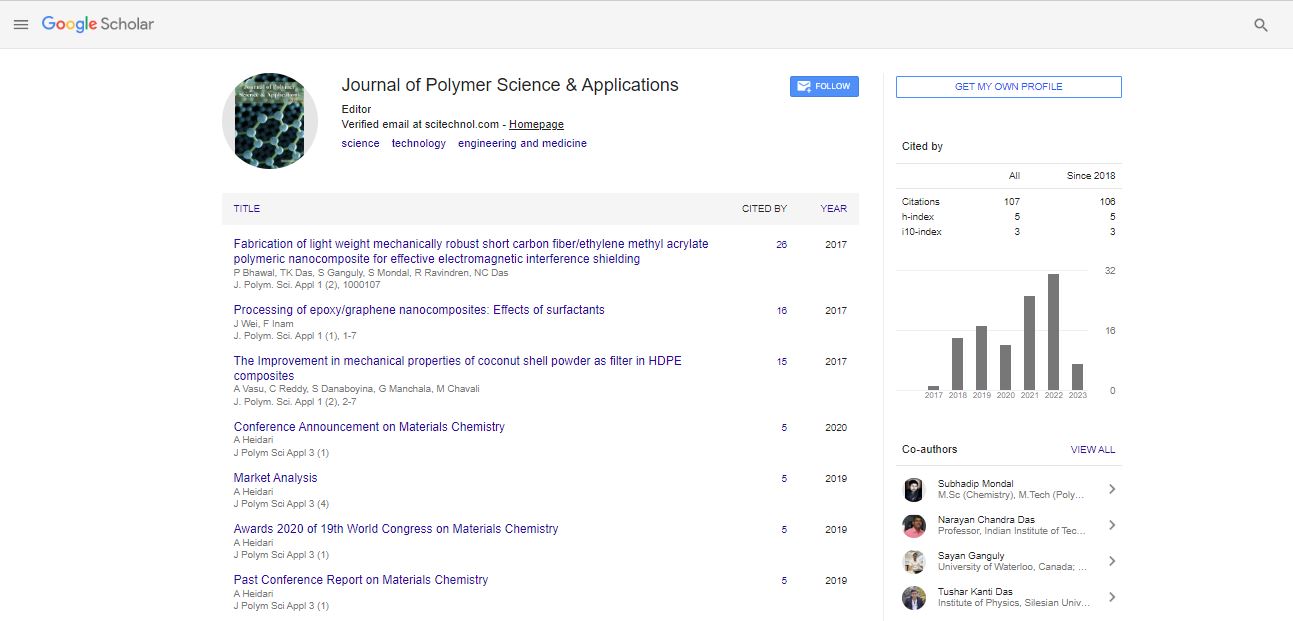Editorial, J Polym Sci Appl Vol: 1 Issue: 1
Looking Forward for the Articles Dealing with Fundamental Science and Applications of Brand-New Polymer Nanocomposites and/or Organic/Inorganic Hybrid Materials
| Chang-Sik Ha* | |
| Department of Polymer Science and Engineering, Pusan National University, Busan 46241, Korea | |
| Corresponding author : Chang-Sik Ha Department of Polymer Science and Engineering, Pusan National University Tel: + 82-51-510-2407 Fax: +82-51-513-7720 E-mail: csha@pusan.ac.kr |
|
| Received: January 24, 2017 Accepted: January 26, 2017 Published: January 26, 2017 | |
| Citation: Chang-Sik Ha (2017) Looking Forward for the Articles Dealing with Fundamental Science and Applications of Brand-New Polymer Nanocomposites and/ or Organic/Inorganic Hybrid Materials. J Polym Sci Appl 1:1 |
Abstract
Polymer Nanocomposites represent a radical alternative to the conventional polymer composites by reinforcing polymers with a second inorganic phase in nanometer dimension.
Keywords: Polymer Nanocomposites, Nanoparticles
| Polymer nanocomposites represent a radical alternative to the conventional polymer composites by reinforcing polymers with a second inorganic phase in nanometer dimension. |
| Depending on how many dimensions of the dispersed phase are in the nanometer range, one can distinguish three different nano composites. First type of nanocomposite corresponds to the case where the reinforcing phase, in the shape of platelets, has only one dimension on a nanolevel. Polymer-layered silicate (PLS) nanocomposites belong to this class. Second, nanocomposites can also be reinforced by a phase which has only two dimensions in the nanometer scale. This is the case for polymer matrices reinforced by cellulose whiskers, nanotubes, or graphene oxides, etc. Third, polymer nanocomposites can be reinforced by isodimensional phases, which have three dimensions in the nanometer range, such as precipitated inorganic nanoparticles, metal oxides synthesized by the sol–gel process, and inorganic particle beads, but also colloidal dispersion of rigid polymers, and many others. |
| Nano-dimension means that the size is pretty close to molecular size. This fundamental length scale dominates morphology and macroscale properties of nanomaterials. This is the reason nanocomposites are different and worthy of rapidly increasing scientific and technological excitement. The term ‘nanocomposites’ describes a two-phase material; here one of the phases has at least one dimension in the nanometer (10−9 m) range. The nano particles have at least one characteristic length scale that is of the order of nanometers and can range from essentially isotropic to highly anisotropic needlelike to sheetlike elements. |
| Uniform dispersion of these isotropic and anisotropic nano sized particles or (nano elements) can lead to an ultralarge interfacial area between nanoelements, which begin to approach molecular dimensions at extremely low loadings of nanoparticles. Thus, for a system comprised of 1 nm thick plates, the distance between plates (considered as discs with a diameter 1 μm) approaches 10 nm at only a few volume % of plates. This large internal interfacial area and the nanoscopic dimensions between constituents differentiate polymer nanocomposites from traditional composites and filled plastics. The dominance of interfacial regions resulting from the nanoscopic phase dimensions implies that the behavior of polymer nanocomposites cannot be understood by simple scaling arguments that begin with the behavior of traditional polymer composites. Three major characteristics form the basis of polymer nanocomposites performance: Nanoscopically confined matrix, nano scale inorganic constituents, and nanobuilding blocks formed from these constituents. |
| Meanwhile, organic-inorganic hybrid composites can cover a broad range of materials consisting of organic materials such as polymers as a matrix and inorganic materials as a dispersant. Organic/inorganic hybrid composites constitute emerging advanced materials since they combine unique properties from the inorganic and organic components. In this sense, polymer nanocomposites are also belonging to the family of organic-inorganic hybrid composites. Since inorganic phases are usually dispersed in organic matrix in the nanometer dimension for most of meaningful organic-inorganic hybrid composites, the multicomponent materials are usually called as organic-inorganic hybrid nanocomposites or organic-inorganic hybrids. Furthermore the inherent nature of organic materials and inorganic materials are fundamentally different each other. Therefore, there are plenty of rooms to investigate the interfacial interaction of organic and inorganic materials in the molecular/nanometer scale, micro/nano-structure and properties of the resultant hybrid materials. Thus a variety of brand-new organic-inorganic hybrid materials may be expected depending on their future applications, while interesting science may lie under such hybrid materials, which comes from interface between organic and inorganic materials. |
| Anyhow, polymer nanocomposites or organic-inorganic hybrid materials are among hot topics in polymer sciences and applications. Thus any hot papers dealing with fundamental science of brand-new polymer based hybrid materials or polymer nanocomposites and their advanced applications in this journal are welcomed. |
 Spanish
Spanish  Chinese
Chinese  Russian
Russian  German
German  French
French  Japanese
Japanese  Portuguese
Portuguese  Hindi
Hindi 